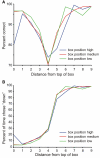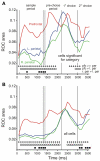Top-down spatial categorization signal from prefrontal to posterior parietal cortex in the primate
- PMID: 21897811
- PMCID: PMC3160627
- DOI: 10.3389/fnsys.2011.00069
Top-down spatial categorization signal from prefrontal to posterior parietal cortex in the primate
Abstract
In the present study we characterized the strength and time course of category-selective responses in prefrontal cortex and area 7a of the posterior parietal cortex during a match-to-sample spatial categorization task. A monkey was trained to categorize whether the height of a horizontal sample bar, presented in rectangular frame at one of three vertical locations, was "high" or "low," depending on whether its position was above or below the frame's midline. After the display of this sample bar, and after a delay, choice bars were sequentially flashed in two locations: at the top and at the bottom of the frame ("choice" epoch). If the monkey timed its response to the display of the choice bar that matched the sample bar, he was rewarded. We found that cells in prefrontal cortex discriminated category early after the initial sample bar was shown, and continued to differentiate "up" from "down" trials throughout the delay and choice periods. In contrast, parietal cells did not differentiate category until the choice period. Therefore, our results support the notion of a top-down categorical signal that originates in prefrontal cortex and that is only represented in parietal cortex when it is necessary to express the categorical decision through a movement.
Keywords: ROC analysis; neurophysiology of categorization; posterior parietal cortex; prefrontal cortex; rhesus monkey.
Figures








References
Grants and funding
LinkOut - more resources
Full Text Sources

